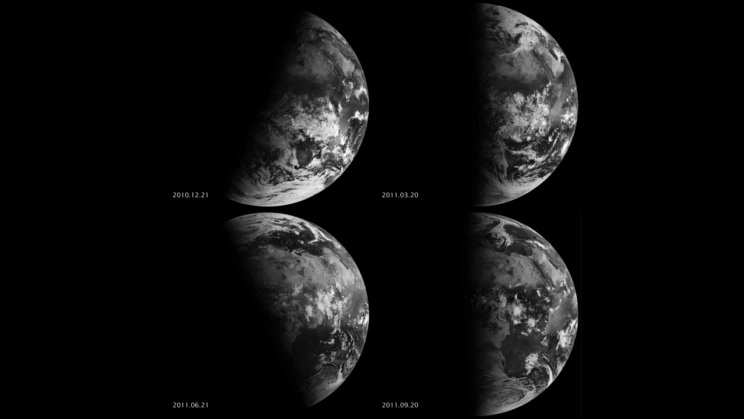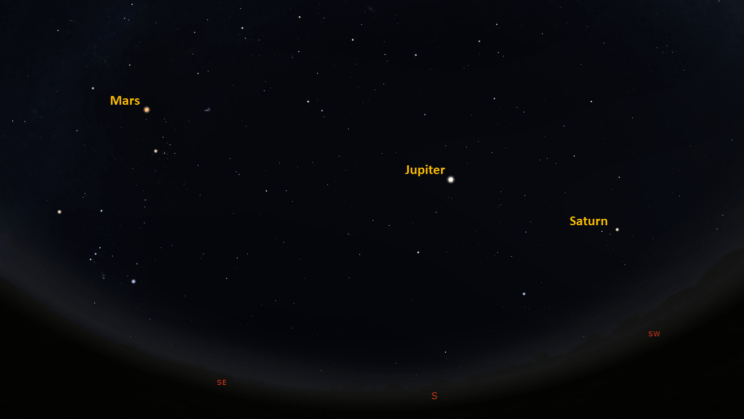This is the Saint Louis Science Center’s NIGHT SKY UPDATE for the week of Friday, December 16, 2022.
Information updated weekly or as needed.
Times given as local St. Louis time which is Central Standard Time (CST). For definitions of terminology used in the night sky update, click the highlighted text. If relying on times posted in Universal Time (UT), St. louis is -6 hours when CST.
Public Telescope Viewings
As part of the Saint Louis Science Center’s First Fridays, weather permitting, the St. Louis Astronomical Society and the Science Center will set up a number of telescopes outdoors and be on-hand to answer your questions. Telescope viewing begins once it is dark. Regardless of the weather on February 3, join us indoors in our planetarium theater for “The Sky Tonight”. Showtime is at 7 p.m.
*** There will not be a First Friday in January 2023. ***
Observing Highlight of the Week

Images of Earth taken by Meteosat-9 showing changing seasons on Earth. Image credit: NASA, EUMETSAT, Robert Simmon.
The winter solstice occurs on December 21, 2022. This officially marks the beginning of winter in the northern hemisphere. It is a day when the Sun will be at its lowest marking the shortest amount of daytime. If you are in the southern hemisphere, December 21, 2022, marks the summer solstice and is when the Sun is seen at its highest.
The term solstice comes from solstitium which means solar standstill. Standstill refers to the extremes of the Sun’s apparent annual motions. The Sun will be seen no lower or no higher in the sky when at local noon. If it is the high point, it is the summer solstice and if it is the low point, it is the winter solstice. The high and low points denote when the Sun reaches its maximum separation from Earth’s celestial equator. This value is 23.5° which denotes the latitudes of the Tropic of Cancer and Capricorn.
The December solstice occurs when Earth is close to its perihelion. Perihelion is when Earth reaches its closest point to the Sun which happens in the first week of January. For 2023, perihelion occurs on January 4.
As we head into winter, the sky we see at night is shifting to favor the winter constellations. In the east you can now see the early winter constellations Taurus and Auriga about 45 minutes after sunset. By 7:00 p.m., you will see the more familiar Orion rising above eastern tree line. These winter patterns can be seen all night long. Early evening they are seen in the east. As Earth rotates Orion will be seen high in the south by midnight and eventually in the west before sunrise.
The Sun and Moon

The Moon as seen from the International Space Station, on July 31, 2011.
Credit: NASA
Sunrise is at 7:12 a.m. on Friday, December 16 and sunset is at 4:41 p.m. providing us with roughly 9.5 hours of daylight. Even after sunset, light from the Sun will dimly illuminate our sky for roughly 1 hour and 30 minutes. This period is called twilight, which ends around 6:17 p.m. this week. For those with a sundial, local noon occurs around 11:56 a.m. this week.
| Day | Sunrise | Sunset |
|---|---|---|
| 2022-12-16 | 7:12 a.m. | 4:41 p.m. |
| 2022-12-17 | 7:13 a.m. | 4:41 p.m. |
| 2022-12-18 | 7:13 a.m. | 4:42 p.m. |
| 2022-12-19 | 7:14 a.m. | 4:42 p.m. |
| 2022-12-20 | 7:14 a.m. | 4:42 p.m. |
| 2022-12-21 | 7:15 a.m. | 4:43 p.m. |
| 2022-12-22 | 7:15 a.m. | 4:43 p.m. |
| 2022-12-23 | 7:16 a.m. | 4:44 p.m. |
| 2022-12-24 | 7:16 a.m. | 4:45 p.m. |
Moon
Moonrise for Friday, December 17 was at 12:42 a.m. and moonset occurs at 12:56 p.m. Friday, December 17, the Moon will exhibit a waning crescent phase with 36% of the lunar disk illuminated. New moon occurs on December 23, 2022, at 4:17 a.m.
International Space Station (ISS) Observing

There are several visible passes of ISS from St. Louis for the week of December 16. They occur during morning hours. The best passes for this week are listed below. Use the table below for information about these passes.
Catch ISS from St. Louis starting Friday, December 16
| Date | Starts | Max. altitude | Ends | |||||||
|---|---|---|---|---|---|---|---|---|---|---|
| Time | Alt. | Az. | Time | Alt. | Az. | Time | Alt. | Az. | ||
| 18 Dec | -3.8 | 06:33:19 | 10 | WSW | 06:36:40 | 64 | NW | 06:40:00 | 10 | NE |
| 19 Dec | -3.5 | 05:45:46 | 17 | SW | 05:48:15 | 69 | SE | 05:51:36 | 10 | NE |
| 21 Dec | -3.3 | 05:47:53 | 39 | NW | 05:48:07 | 40 | NNW | 05:51:19 | 10 | NE |
Magnitude (Mag): The Measure of brightness for a celestial object. The lower the value is, the brighter the object will be.
Altitude (Alt): The angle of a celestial object measured upwards from the observer’s horizon.
Azimuth (Az): The direction of a celestial object, measured clockwise from an observer’s location with north being 0°, east being 90°, south being 180° and west being 270°.
For information about ISS flyovers and other visible satellites, visit www.heavens-above.com
Detailed information regarding all unmanned exploration of our universe, missions past, present, and planned, can be found at Jet Propulsion Laboratories:
The Visible Planets

Looking south at 7:00 p.m. on December 17, 2022. Credit: Stellarium, EG

Looking south at 3:00 a.m. on December 18, 2022. Credit: Stellarium, EG.
This week, five naked eye planets are visible. Mars rises in the early evening and is visible most of the night. Jupiter and Saturn rise before sunset and will be visible once it is dark. Venus and Mercury are climbing out of the Sun’s glare in the west after sunset.
Mercury
Mercury is climbing out of the Sun’s glare this week becoming visible in the west shortly after sunset. Mercury reaches greatest eastern elongation on December 21, 2022. As we get closer to this date, Mercury should be easy to spot.
Venus
Like Mercury, Venus is climbing out of the Sun’s glare. By the end of December, Venus should be an easy target to spot after sunset in the west. For now, those with clear western views my catch a glimpse of Venus low in the west at the end of the week. Venus is starting an evening apparition. Once high enough above the horizon, Venus will be a bright target in the west after sunset until August 2023 when it approaches inferior conjunction.
Mars
Mars now rises before sunset becoming visible once it is dark. Look for it in the east about 30 minutes after sunset.
Jupiter
Now past opposition, Jupiter will be visible about 30 minutes after sunset. Jupiter reaches superior conjunction on April 11, 2023. As we progress towards this date, we will see Jupiter slowly wander towards the Sun.
Saturn
Now past opposition, Saturn rises before the Sun sets. You can find this giant world in the south about 45 minutes after sunset. Saturn is still a fine target though telescopes and will be a highlight of the evening sky for the rest of the year.
James S. McDonnell Planetarium
Night Sky Update: December 16 – December 24, 2022






